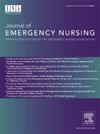急诊科致命性评估计划:计划实施与评估。
IF 1.8
4区 医学
Q2 EMERGENCY MEDICINE
引用次数: 0
摘要
导言:尽管对亲密伴侣暴力进行了常规筛查,并对致命性筛查工具进行了验证,但在医疗机构中,亲密伴侣暴力评估和服务链接仍不一致。该项目旨在实施和评估一项致命性评估计划,这是一项由护士主导的筛查和预防亲密伴侣暴力杀人的计划,该计划在急诊科与当地社区机构合作开展:方法: 采用单组前-后设计,评估急诊科 143 名注册护士对亲密伴侣暴力和致命性评估计划协议的认识变化,以及对实施协议的信心。计划成果在实施后的 4 个月内进行评估。对焦点小组访谈进行了分析,以确定实施过程中的障碍和促进因素:结果:护士们在实施计划的知识和信心方面均有显著提高(P< .001)。在 4 个月的时间里,共完成了 14 次致命性筛查,其中 13 次表明亲密伴侣暴力杀人危险性较高。8 名受害者接受了当地社区组织提供的 20 项服务(1-5 项/人):紧急庇护所、安全规划、法律援助和家庭暴力保护令。实施过程中遇到的障碍包括时间、隐私、培训和获取筛查表格。促进因素包括支持者、实施资源和提示:讨论:致命性评估计划是医疗保健环境中的一个可行方案,可提高对亲密伴侣暴力的认识,将高危亲密伴侣暴力受害者与所需服务实时联系起来,并有可能减少亲密伴侣暴力杀人事件。这样的计划对于解决这一公共卫生问题至关重要。本文章由计算机程序翻译,如有差异,请以英文原文为准。
A Lethality Assessment Program in the Emergency Department: Program Implementation and Evaluation
Introduction
Despite routine screening for intimate partner violence and validated screening tools for lethality, intimate partner violence assessment and linkage to services remain inconsistent in health care settings. This program aimed to implement and evaluate a lethality assessment program, a nurse-led screening and prevention program for intimate partner violence homicide in an emergency department that partnered with a local community agency.
Methods
A single group pre−post design was used to evaluate changes in knowledge of intimate partner violence and the lethality assessment program protocol and confidence in implementing the protocol among 143 registered nurses in the emergency department. Program outcomes were assessed during a 4-month post-implementation period. Focus group interviews were conducted and analyzed to identify barriers and facilitators of implementation.
Results
Significant improvements in the nurses’ knowledge and confidence in implementing the protocol (all P< .001) were observed. Fourteen lethality screens were completed during the 4 months, with 13 indicating high intimate partner violence homicide danger. Eight victims received 20 services (1-5/person) from the local community organization: emergency shelter, safety planning, legal aid, and domestic violence protection order. Barriers to implementation included time, privacy, training, and access to screening forms. Facilitators included champions, resources to allow for implementation, and prompts.
Discussion
The lethality assessment program is a feasible protocol in a health care setting to increase intimate partner violence awareness, link high-risk intimate partner violence victims to needed services in real time, and potentially reduce intimate partner violence homicides. Programs like this are essential to address this public health concern.
求助全文
通过发布文献求助,成功后即可免费获取论文全文。
去求助
来源期刊
CiteScore
3.10
自引率
11.80%
发文量
132
审稿时长
46 days
期刊介绍:
The Journal of Emergency Nursing, the official journal of the Emergency Nurses Association (ENA), is committed to the dissemination of high quality, peer-reviewed manuscripts relevant to all areas of emergency nursing practice across the lifespan. Journal content includes clinical topics, integrative or systematic literature reviews, research, and practice improvement initiatives that provide emergency nurses globally with implications for translation of new knowledge into practice.
The Journal also includes focused sections such as case studies, pharmacology/toxicology, injury prevention, trauma, triage, quality and safety, pediatrics and geriatrics.
The Journal aims to mirror the goal of ENA to promote: community, governance and leadership, knowledge, quality and safety, and advocacy.

 求助内容:
求助内容: 应助结果提醒方式:
应助结果提醒方式:


